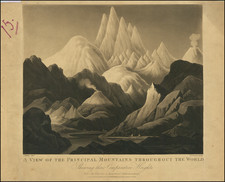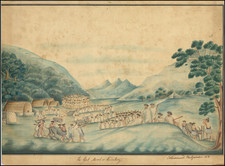Rare lithographic image of Waterfalls of the Tji-Geurree River with Nearby Forests, from Carl Ludwig Blume's monumental botanical work.
The image appeared in Carl Ludwig Blume's Rumphia, sive, Commentationes botanicæ imprimis de plantis Indiæ Orientalis : tum penitus incognitis tum quæ in libris Rheedii, Rumphii, Roxburghii, Wallichii aliorum recensentur / scripsit C.L. Blume cognomine Rumphius, published in Leiden between 1835 and 1848.
The work includes Blume's commentary on plants of the East Indies includes 213 beautiful hand-colored engravings. Blume's Rumphia is monumental work in the annals of botanical literature. Published over a period of thirteen years in Leiden, from 1835 to 1848, this seminal work provides an exhaustive examination of the flora of the East Indies. Blume's work is not only a scientific tour de force but also a bridge connecting the then-contemporary botanical knowledge with the observations of earlier naturalists such as Rheed, Rumphius, Roxburgh, and Wallich.
In the first paragraph of this text, Blume masterfully intertwines a description of the botanical richness of the East Indies with a historical perspective, emphasizing the region's significance in the development of botanical science. The East Indies, known for their luxuriant and diverse vegetation, had long captivated the interest of European botanists. By the early 19th century, numerous works had been published describing its flora, yet Blume's Rumphia distinguishes itself by its breadth and detail.
Blume meticulously documents and categorizes a vast array of plant species, many of which were previously unknown or inadequately described in earlier literature. His descriptions are precise and accompanied by detailed illustrations, which not only serve as a visual guide but also as an artistic homage to the exotic beauty of these species.
Furthermore, Blume's contribution to botanical nomenclature and classification in this work is significant. He revises and refines the taxonomic classifications of many plant species, providing clarity and coherence to the complex botanical lexicon. His approach reflects a keen analytical mind, adept at synthesizing information from various sources to present a more comprehensive understanding of the flora.
In the final paragraphs, the focus shifts to the lasting impact of Rumphia on the field of botany. This work, with its extensive descriptions and classifications, became a foundational reference for subsequent botanical studies in the region. It not only enriched the scientific community's understanding of tropical botany but also laid the groundwork for future botanical explorations and discoveries in the East Indies.
Carl Ludwig Blume
Carl Ludwig Blume, a German-born botanist (1796-1862), spent the majority of his professional life in the Dutch East Indies and the Netherlands after studying at Leiden University. In 1819, he embarked on a significant journey to Southeast Asia, primarily residing in Java, a Dutch colony, where he undertook comprehensive research on the region's flora, fauna, and epidemics. By 1823, Blume had risen to the position of Deputy Director of Agriculture at Java's Buitenzorg (Bogor Gardens), following years of extensive field study and collection of local plant and animal specimens. His return to Europe in 1827 was marked by his transport of over 3,000 plant specimens to Leiden, and he subsequently assumed the role of Director of the Rijksherbarium (state herbarium).
Blume's extensive field research culminated in several significant publications, including the expansive "Flora Javae" (1828-1851), focusing on the plant life of Java and nearby islands, and "Rumphia" (1835-1848), which broadened its scope to encompass the Melasia region. "Rumphia," published across four volumes, is notable for its 210 lithographed plates, primarily hand-colored, crafted by notable draftsmen like A.A.J. Payen and J.C.P. Arckenhausen. These intricate illustrations depict the plants in detailed physical likeness and are complemented by thorough Latin text. The work honors German botanist Georg Rumphius, renowned for his seminal catalogue on the flora of Amboina, published posthumously in 1741.









![[Portrait] L'Asie.](https://storage.googleapis.com/raremaps/img/small/79746.jpg)
![[ Plasterers Company -- Certification of Master Plasterer Edward Evans ]](https://storage.googleapis.com/raremaps/img/small/97322.jpg)

![[Allegory of America, from a Series of the Continents]](https://storage.googleapis.com/raremaps/img/small/94152.jpg)

